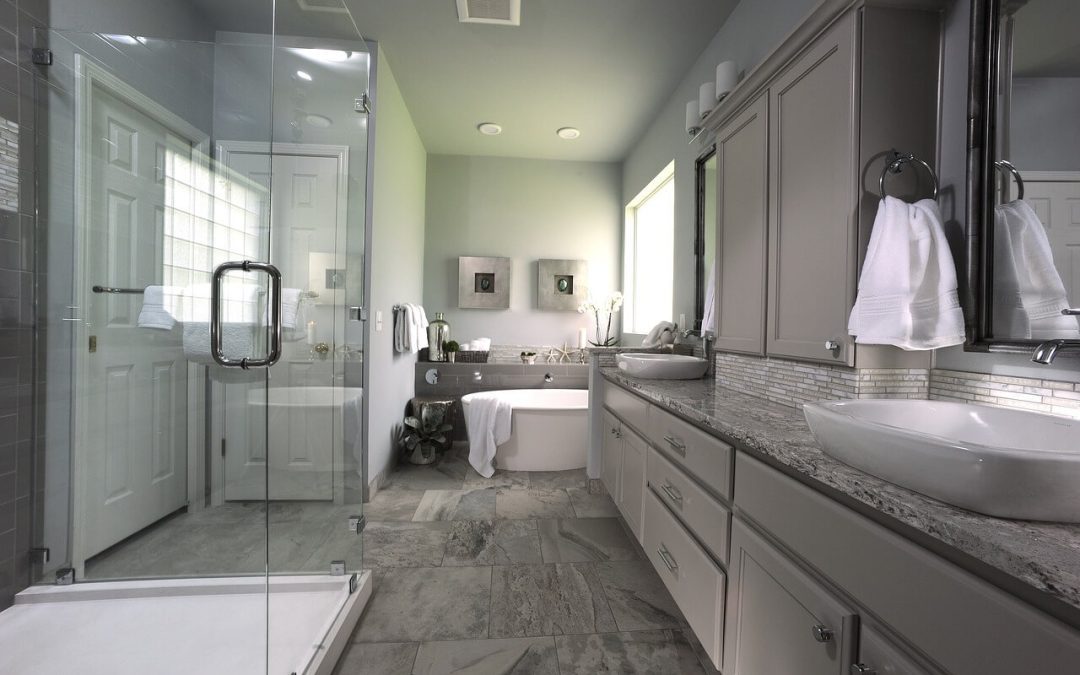Choosing the right flooring for your bathroom is essential when it comes to home renovations. The bathroom is a high-traffic area, and the flooring materials need to be durable enough to withstand humidity, water spills, and frequent cleaning. Whether planning a modern update or a classic remodel, this guide on bathroom flooring options will help you find the best material for your home.
Popular Bathroom Flooring Options
Luxury Vinyl Flooring
One of the most adaptable flooring materials is luxury vinyl. It’s water-resistant and resilient and offers a comfortable underfoot feeling, making for a more pleasant morning routine. Luxury vinyl tiles (LVT) and planks (LVP) come in an astonishing range of styles that mimic the look of pricier materials like hardwood or stone without breaking the bank.
Pros:
Water-resistant and resilient
Diverse range of styles
Affordable
Cons:
Can be punctured by sharp objects
Not as valuable as real wood or stone when you sell your home
Porcelain and Ceramic Tiles
The most classic choice for bathroom flooring is porcelain or ceramic tile. These materials are known for their durability and water resistance. Porcelain, being denser, is less porous and more resistant to moisture and stains, making it an excellent choice for a humid bathroom. Both come in diverse designs, shapes, and sizes, allowing you to create a custom look.
Pros:
Waterproof
Durable and long-lasting
Versatile design options
Cons:
Cold and hard underfoot
Grout lines can become stained and require maintenance
Natural Stone as an Option for Bathroom Flooring
Elegant and always stylish, natural stone – including marble, granite, and slate – adds luxury to any bathroom. Stone is durable and improves with age, and each piece’s unique veining and patterns mean no two floors are alike. Regular sealing is necessary to maintain its water-resistant properties.
Pros:
Luxurious and unique
Highly durable
Cons:
Expensive
Requires sealing
Can be slippery
Stained Concrete
Concrete is making a comeback, particularly in industrial-style or modern homes. Stained concrete gives you a sleek look combined with rugged durability. It can be sealed to resist water, and you can opt for textures to make it slip-proof. Concrete is a good choice for those seeking a minimalist or unconventional aesthetic.
Pros:
Inexpensive
Highly durable
Modern and versatile
Cons:
Cold and hard underfoot
May look too industrial for some tastes
Bathroom Flooring: Sheet Vinyl
If you need a waterproof and budget-friendly option for your bathroom, sheet vinyl can be a good option. Unlike vinyl tiles or planks, sheet vinyl comes in larger rolls, reducing the number of seams where water can infiltrate. It’s an ideal solution for a kid’s bathroom or high-moisture areas.
Pros:
Waterproof
Inexpensive
Comfortable to walk on
Cons:
Fewer design options than tiles or planks
Can be damaged by sharp objects
When selecting bathroom flooring, consider durability, safety, aesthetics, and budget. Flooring influences your bathroom’s look and functionality. Visiting your local home improvement store or consulting with a professional will give you a better idea of what these options look and feel like. Your flooring should reflect the home’s character and lifestyle while providing the best performance for your family’s needs.
FAQs
Which bathroom flooring material is easiest to maintain?
Vinyl flooring is the easiest to maintain in bathrooms. It’s water-resistant, durable, and easy to clean with regular sweeping and occasional mopping.
Can I install bathroom flooring myself, or should I hire a professional?
The answer depends on your level of DIY experience and the type of flooring you choose. Some materials, like luxury vinyl tile (LVT) or laminate, offer straightforward installation processes suitable for DIY enthusiasts. However, for more complex materials like ceramic tile or natural stone, hiring a professional installer is recommended for proper preparation, installation, and sealing to prevent water damage and ensure longevity.
If I like the look of stone flooring, in what other areas of the house can I use this material?
Stone flooring, such as marble, granite, and slate, adds elegance to the home. Aside from bathrooms, you can use stone flooring in kitchens, entryways, or living spaces to create a cohesive and luxurious look throughout your home.
What is the difference between porcelain and ceramic tile flooring?
Porcelain and ceramic tiles are popular choices for bathroom flooring, but they have some differences. Porcelain tiles are denser, more durable, and less porous than ceramic tiles, making them highly water-resistant and suitable for high-traffic areas like bathrooms. Ceramic tiles are generally less expensive and come in a wider range of colors and designs, but may require more maintenance and sealing to prevent water damage.
Are there bathroom flooring options that are better in homes with elderly family members?
For homes with elderly family members, it’s essential to choose flooring that prioritizes safety and accessibility. Non-slip materials like textured ceramic or porcelain tiles, vinyl, or rubber flooring are excellent options as they provide better traction, reducing the risk of slips and falls. Materials like luxury vinyl or cork offer cushioning and warmth underfoot, making them more comfortable for elderly individuals who may spend more time standing in the bathroom.
GoPro Home Inspections offers inspection services to homebuyers and sellers. Contact us to schedule an appointment.

